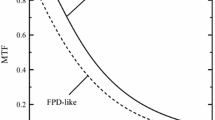Abstract
We propose a method for measuring the modulation transfer function (MTF) of a computed tomography (CT) system by use of a circular edge method with a logistic curve-fitting technique. An American College of Radiology (ACR) phantom was scanned by a Philips Brilliance system, and axial images were reconstructed by the filtered back projection algorithm with a standard reconstruction filter. The radial MTF was measured from a disk image of a rod or cylinder in the ACR phantom by use of the circular edge method. In this study, we applied a logistic curve-fitting technique to an edge-spread function (ESF) to eliminate noise because the edge method is very susceptible to noise in the ESF in a CT image. The circular edge method with the logistic curve-fitting technique provided the MTF without fluctuations due to noise for the entire spatial frequency range. The MTF was not affected by the tube current, the slice thickness, or the disk contrast, which were factors related to the amount of noise in the CT image. However, the MTF was affected by the location of the disk and by the disk size, depending on the average distance from the isocenter to the disk edge. Our results indicated that the MTF measured by the circular edge method with the logistic curve-fitting technique was not susceptible to noise in CT images. Therefore, this method is useful for MTF measurement for not only high-contrast objects, but also low-contrast objects with a large amount of noise.









Similar content being viewed by others
References
Judy PF. The line spread function and modulation transfer function of a computed tomographic scanner. Med Phys. 1976;3(4):233–6.
Borasi G, Castellani G, Domenichini R, Franchini M, Granata M, Torresin A, Tosi G. Image quality and dose in computerized tomography: evaluation of four CT scanners. Med Phys. 1984;11(3):321–5.
Boone JM. Determination of the presampled MTF in computed tomography. Med Phys. 2001;28(3):356–60.
Mori I, Machida Y. Deriving the modulation transfer function of CT from extremely noisy edge profiles. Radiol Phys Technol. 2009;2(1):22–32.
McCollough CH, Bruesewitz MR. The phantom portion of the American College of Radiology (ACR) computed tomography (CT) accreditation program: practical tips, artifact examples, and pitfalls to avoid. Med Phys. 2004;31(9):2423–42.
Thibault JB, Sauer KD, Bouman CA, Hsieh J. A three-dimensional statistical approach to improved image quality for multislice helical CT. Med Phys. 2007;34(11):4526–44.
Richard S, Husarik DB, Yadava G, Murphy SN, Samei E. Towards task-based assessment of CT performance: system and object MTF across different reconstruction algorithms. Med Phys. 2012;39(7):4115–22.
Wilson JM, Christianson OI, Richard S, Samei E. A methodology for image quality evaluation of advanced CT systems. Med Phys. 2013;40(3):0319081–9.
Friedman SN, Fung GS, Siewerdsen JH, Tsui BM. A simple approach to measure computed tomography (CT) modulation transfer function (MTF) and noise-power spectrum (NPS) using the American College of Radiology (ACR) accreditation phantom. Med Phys. 2013;40(5):0519071–9.
Samei E, Flynn MJ. A method for measuring the presampled MTF of digital radiographic systems using an edge test device. Med Phys. 1998;25(1):102–13.
Schafer RW. What is a Savitzy–Golay filter? IEEE Signal Process Mag. 2011;28:111–7.
Maidment AD, Albert M. Conditioning data for calculation of the modulation transfer function. Med Phys. 2003;30(2):248–53.
Otsu N. A threshold selection method from gray-level histograms. IEEE Trans Syst Man Cybern. 1979;9(1):62–6.
Bishop CM. Pattern recognition and machine learning. Singapore: Springer; 2006. p. 207–8.
Gradshteyn IS, Ryzhik IM. Table of integrals, series, and products. 5th ed. San Diego: Academic Press; 1994. p. 908.
Bischof CJ, Ehrhardt JC. Modulation transfer function of the EMI CT head scanner. Med Phys. 1977;4(2):163–7.
Nickoloff EL. Measurement of the PSF for a CT scanner: appropriate wire diameter and pixel size. Phys Med Biol. 1988;33:149–55.
Hsieh J. Computed tomography: principles, design, artifacts, and recent advances. Bellingham: SPIE Press; 2003. p. 113–8.
Acknowledgments
This work was supported by JSPS KAKENHI Grant Number 22611014.
Conflict of interest
The authors declare that they have no conflict of interest.
Author information
Authors and Affiliations
Corresponding author
About this article
Cite this article
Takenaga, T., Katsuragawa, S., Goto, M. et al. Modulation transfer function measurement of CT images by use of a circular edge method with a logistic curve-fitting technique. Radiol Phys Technol 8, 53–59 (2015). https://doi.org/10.1007/s12194-014-0286-x
Received:
Revised:
Accepted:
Published:
Issue Date:
DOI: https://doi.org/10.1007/s12194-014-0286-x




